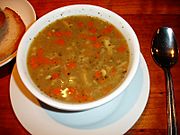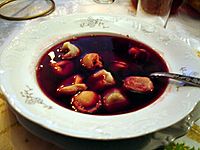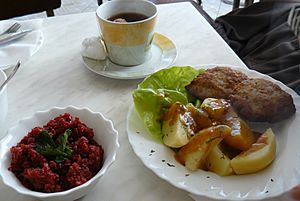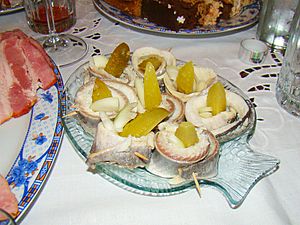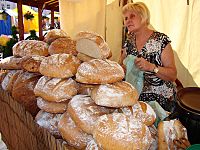Polish cuisine facts for kids
Polish cuisine (Polish: kuchnia polska) is a style of cooking and food preparation originating in or widely popular in Poland. Polish cuisine has evolved over the centuries to become very eclectic due to Poland's history and it shares many similarities with other regional cuisines. Polish-styled cooking in other cultures is often referred to as à la polonaise.
Polish cuisine is rich in meat, especially pork, chicken and game, in addition to a wide range of vegetables, spices, mushrooms, and herbs. It is also characteristic in its use of various kinds of noodles as well as cereals and grains. In general, Polish cuisine is hearty and heavy in its use of butter, cream, eggs and extensive seasoning. The traditional dishes are often demanding in preparation. Many Poles allow themselves a generous amount of time to serve and enjoy their festive meals, especially Christmas Eve supper (Wigilia) on December 24 or Easter breakfast, which could take a number of days to prepare in their entirety.
Among the well-known Polish national dishes are bigos [ˈbiɡɔs]; pierogi [pʲɛˈrɔɡʲi]; kiełbasa; pork loin kotlet schabowy breaded cutlet [ˈkɔtlɛt sxaˈbɔvɨ]; gołąbki cabbage roll [ɡɔˈwɔ̃pkʲi]; zrazy roulade [ˈzrazɨ]; sour cucumber soup (zupa ogórkowa) [ˈzupa ɔɡurˈkɔva]; mushroom soup, (zupa grzybowa) [ˈzupa ɡʐɨˈbɔva]; tomato soup (zupa pomidorowa) [ˈzupa pɔmidɔˈrɔva]; rosół meat broth [ˈrɔsuw]; żurek sour rye soup [ˈʐurɛk]; flaki tripe soup [ˈflakʲi]; and red beetroot barszcz [barʂt͡ʂ].
A traditional Polish dinner is composed of three courses, beginning with a soup like the popular rosół broth and tomato soup. At restaurants, the soups are followed by an appetizer such as herring (prepared in either cream, oil, or in aspic); or other cured meats and vegetable salads. The main course usually includes a serving of meat, such as roast, breaded pork cutlet, or chicken, with a coleslaw-like surówka [suˈrufka], shredded root vegetables with lemon and sugar (carrot, celeriac, seared beetroot), sauerkraut or mizeria salad. The side dishes are usually boiled potatoes, kasza or less commonly rice. Meals often conclude with a dessert including makowiec, a poppy seed pastry, napoleonka cream pie or sernik cheesecake.
Internationally, if a Polish culinary tradition is used in other cuisines, it is referred to as à la polonaise, from French meaning 'Polish-style.' In France, the use of butter instead of cooking oil, frying vegetables with buttered breadcrumbs, minced parsley and boiled eggs (Polonaise garnish) as well as adding horseradish, lemon juice or sour cream to sauces like Velouté is known under this term.
History
Middle Ages
Polish cuisine in the Middle Ages was based on dishes made of agricultural produce and cereal crops (millet, rye, wheat), meats of wild and farm animals, fruits, forest berries and game, honey, herbs and local spices. It was known above all for abundant use of salt from Wieliczka and permanent presence of groats (kasza). A high calorific value of dishes and drinking beer or mead as a basic drink was typical of Middle Ages Polish cuisine.
During the Middle Ages the cuisine of Poland was heavy and spicy. Two main ingredients were meat (both game and beef) and cereal. The latter consisted initially of proso millet, but later in the Middle Ages other types of cereal became widely used. Most commoners did not use bread and instead consumed cereals in the forms of kasza or various types of flatbread, some of which (for instance kołacz) are considered traditional recipes even in the 21st century. Apart from cereals, a large portion of the daily diet of mediaeval Poles consisted of beans, mostly broad beans and peas. As the territory of Poland was densely forested, usage of mushrooms, forest berries, nuts and wild honey was also widespread. Among the delicacies of the Polish nobility were honey-braised bear paws served with horseradish-flavoured salad (now species protected in Poland), smoked bear tongue and bear bacon.
Thanks to close trade relations with Turkey and the countries in the Caucasus, the price of spices (such as black pepper and nutmeg) was much lower in Poland than the rest of Europe, hence spicy sauces became popular. The usage of two basic sauces (the jucha czerwona and jucha szara, or red and gray blood in Old Polish) remained widespread at least until the 18th century.
The daily beverages included milk, whey, buttermilk and various herb infusions. The most popular alcoholic beverages were beer and mead; however in the 16th century upper classes began to import Hungarian and Silesian wines. Mead was so widespread that in the 13th century Prince Leszek I the White explained to the Pope that Polish knights could not participate in a crusade as there was no mead in the Holy Land. Also, vodka became popular, possibly among the lower classes first. There is written evidence suggesting that vodka originated in Poland. The word "vodka" was recorded for the first time ever in 1405 in Akta Grodzkie, the court documents from the Palatinate of Sandomierz in Poland. At that time, the word wódka (vodka) referred to chemical compounds such as medicines and cosmetic cleansers, while the popular beverage was called gorzałka [ɡɔˈʐawka] (from the Old Polish gorzeć).
Renaissance
Along with the Italian queen Bona Sforza (second wife of Sigismund I of Poland) many Italian cooks came to Poland after 1518. Although native vegetable foods were an ancient and intrinsic part of the cuisine, this began a period in which vegetables like lettuce, leeks, celeriac and cabbage were more widely used. Even today, some of those vegetables are referred to in Polish as włoszczyzna, a word derived from Włochy, the Polish name of Italy. During this period the use of spices, which arrived in Poland via Western Asian trade routes, was common among those who could afford them, and dishes considered elegant could be very spicy. However, the idea that Queen Bona was the first to introduce vegetables to Poland is false. While her southern cooks may have helped elevate and expand the role of various vegetables in royal Polish cuisine, records show that the court of king Jogaila (in Polish Władysław II Jagiełło, who died in 1434, over 80 years before her reign) enjoyed a variety of vegetables including lettuce, beets, cabbage, turnip, carrots, peas and cauliflower.
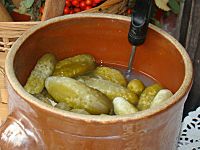
Polish-style pickled cucumber (ogórek kiszony) is a variety developed in the northern part of Central Europe. It has been exported worldwide and is found in the cuisines of many countries. It is usually preserved in wooden barrels. A cucumber only pickled for a few days is different in taste (less sour) than one pickled for a longer time and is called ogórek małosolny, which means "lightly salted cucumber". Another kind of pickled cucumber, popular in Poland, is ogórek konserwowy (preserved cucumber) which is preserved with vinegar rather than pickled and uses different spices creating a sweet and sour taste.
The only indisputable fact is that the court of Queen Bona was fed in an Italian fashion, because she exclusively employed Italian cooks, some of whom were originally hired to prepare parties for aristocratic families but who were soon serving typical Italian dishes as part of the court's daily menus. Court records show that Queen Bona imported large volumes of southern European, American and Western Asian fruits (oranges, lemons, pomegranates, olives, figs, tomatoes), vegetables (potatoes and corn), nuts (chestnuts, raisins and almonds, including marzipan), along with grains (such as rice), cane sugar and Italian olive oil. The court also imported various herbs and spices including black pepper, fennel, saffron, ginger, nutmeg, cloves and cinnamon.
The Polish–Lithuanian Commonwealth

Until the Partitions perpetrated by the neighbouring empires, Poland was one of the largest countries in the world, and encompassed many regions with their own, distinctive culinary traditions. Two consecutive Polish kings, Władysław IV and John II Casimir (Polish: Jan II Kazimierz Waza) married the same French Duchess, Marie Louise Gonzaga (Polish: Ludwika Maria), daughter of Charles I, Duke of Mantua; persecuted by King Louis XIII of France for her affiance to his opponent Gaston, Duke of Orléans. Marie Louise arrived in Warsaw in 1646, was widowed, and married again in 1649. Ludwika brought along with her a court full of Frenchmen including courtiers, secretaries, army officers, physicians, merchants, craftsmen, as well as many cooks.
Records show that her visiting guests were entertained with forest game, and the following fowl: waxwings; fieldfares; snow bunting; hazel grouse; partridges; black grouse; capercaillies; plus fish and molluscs: loach; various trout; grayling; salmon fresh and smoked; flounder, salted herring; lampreys in vinegar; oysters; snails; and Genoese pâté, not to mention fresh fruit and chestnuts. French and Italian wines were served, as well as mead and local beers. The dishes were made only according to French recipes. The royal court with all its innovations exerted a broad influence over the rest of aristocratic residences and noble palaces across Poland. French cuisine was in fashion and many families willingly employed French cooks and pâté makers. In the mid-18th century on Polish tables appeared the French champagne.
Among the most influential cuisines under the Polish–Lithuanian Commonwealth were Lithuanian, Jewish, German and Hungarian cuisine, as well as Armenian cuisine, which arrived in Poland before the 17th century along with many settlers especially in the south-eastern part of the Commonwealth. Signature dishes of the Western Asia reached Polish tables thanks to the Armenian trade and cultural exchange with Poland's neighbour - the Ottoman Empire. Rare delicacies were brought to royal court as gifts from sultans and royal envoys. The strongest influences were noted in the cities of Lwów, Kraków, Kamieniec Podolski and Zamość due to many Armenians living there permanently. Also, because of the close contact with the Ottoman Empire, coffee (kawa) and boza became popular.
With the subsequent decline of Poland, and the grain production crisis that followed The Deluge, potatoes began to replace the traditional use of cereal. The oldest surviving Polish cook-book, Compendium ferculorum, albo Zebranie potraw ("Collection of Dishes") by Stanisław Czerniecki was published in Kraków in 1682. Under the partitions, the cuisine of Poland became heavily influenced by cuisines of the surrounding empires. This included Russian and German cuisines, but also the culinary traditions of most nations of the Austro-Hungarian empire. The 19th century also saw the creation of many Polish cookbooks, by Jan Szyttler, Anna Ciundziewicka, Wincenta Zawadzka, Lucyna Ćwierczakiewiczowa and others.
After World War II
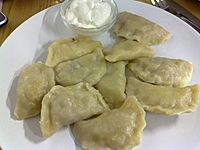
After the end of World War II, Poland became a communist country which joined the Warsaw Pact. Some restaurants were nationalized. The communists envisioned a net of lunch rooms called "bufet" for the workers at various companies, and milk bars for the public. The majority of restaurants that survived the 1940s and 1950s were state-owned. Workplace lunch rooms promoted mostly inexpensive meals, including soups of all kinds, meatballs and pork chops, and staples such as placki ziemniaczane/kartoflane (potato pancakes), placki z jablkami (apple pancakes), kopytka (potato gnocchi), leniwe (farmer's cheese gnocchi served sweet) and pierogi. A typical second course consisted of meat cutlet served with potatoes or buckwheat and "surówka" (raw, julienned vegetables). The popular Polish kotlet schabowy is a breaded cutlet similar to the Austrian Wiener schnitzel and the Italian and Spanish Milanesa.
With time, the shortage economy led to scarcity of meat, coffee, tea and other ingredients of daily use. Many products like chocolate, sugar and meat were rationed, with a specific limit depending on social class and health requirements. Physical workers and pregnant women were generally entitled to more food products. Imports were restricted, so much of the food supply was domestic. Cuisine became homogeneous, to be a chef was no longer a prestigious profession and for decades the country became basically disconnected from any foreign cuisine. Tropical fruits (citrus, banana, pineapple, etc.) were available during holidays and local fruits and vegetables were mostly seasonal but were available at private stands. For most of the year the Poles had to get by with only domestic winter fruit and vegetables: apples, plums, currants, onions, potatoes, cabbage, root vegetables and frozen products. Other food products (of foreign origins) were available at markets at high prices.
This situation led in turn to gradual replacement of traditional Polish cuisine with food prepared from anything available at the moment. Among the popular dishes introduced by the public restaurants was "kotlet mielony" meatball, a sort of a hamburger often served with beet puree and fresh carrots. The traditional recipes were mostly preserved during the Wigilia feast (Christmas Eve), for which many families tried to prepare 12 traditional courses.
A popular form of fish dish was, and still is the paprikash (paprykarz szczeciński) from the port city of Szczecin, usually added to sandwiches as a spread.
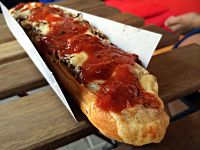
Modern era
With the fall of communism in Poland in 1989, a wave of new restaurants opened and the basic foodstuffs were once again easily obtainable. This led to a gradual return of rich traditional Polish cuisine, both in home cooking and in restaurants. At the same time, restaurants and supermarkets promoted the use of ingredients typical of other cuisines of the world. Among the most notable foods that started to become common in Poland were cucurbits, zucchini and all kinds of fish. During communist times, these were available fresh mostly in the seaside regions.
Recent years have seen the advent of a slow food movement, and a number of TV programmes devoted to other cuisine and as well as traditional Polish cuisine have gained popularity. In 2011 a nostalgic cookbook (written in English) combining a child's memories growing up in the Gierek era with traditional Polish recipes was published in London.
American food in Poland, most commonly McDonald's, KFC and Pizza Hut, are declining in popularity as Polish people prefer their own cuisine, including fast food. Meanwhile, Doner kebabs are gaining popularity. Nonetheless, in most of Poland one can still get traditional and very popular Polish street food such as the zapiekanka, a pizza-like baguette with cheese, mushrooms, onion, sometimes meat and ketchup. There are also many small-scale, quick-service restaurants which usually serve kebabs, hamburgers, hot dogs and Polish kiełbasa sausage. In the southern mountainous region, the oscypek served with cranberry jam is a popular street food.
Holiday meals
Christmas dishes
Traditional Christmas Eve supper called Wigilia is meatless except for fish, usually consists of barszcz (borscht) with uszka (small dumplings) – a classic Polish Christmas Eve starter, followed by fried carp, carp fillet or cod with apple & leeks fresh salad, carp in aspic etc. traditionally carp (fried or Jewish style) provides a main component of the Christmas Eve meal across Poland. Other popular dishes, for the next day, include pickled matjas herring, rollmops, pierogi with sauerkraut and forest mushrooms, fish soup, kiełbasa, hams and bigos (savory stew of cabbage and meat) and vegetable salads. Among popular desserts are gingerbread, cheesecake, various fruits like oranges among others, poppy seed cake makowiec (makówki in Silesia), fruit kompot, kluski with poppyseed and gingerbread. Regional dishes include żurek, siemieniotka (in Silesia) and kołduny, stuffed dumplings with mushrooms or meat from the eastern regions.
Fat Thursday
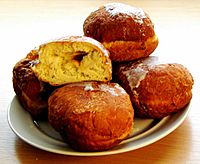
Tłusty Czwartek or "Fat Thursday", is a Polish culinary custom on the last Thursday before Lent, it is equivalent to Pancake Day. Traditionally it is an occasion to enjoy sweets and cakes before the forty days of abstinence expected of Catholics until Easter Day.
The most popular sweetmeats on Fat Thursday are pączki, Polish doughnuts, "faworki", sometimes called, "chrust", equivalent to the French beignet. Traditional Polish doughnuts are filled with rose petal jam, plum jam or apple and covered with icing with orange peel or powdered with icing sugar. Fat Thursday used to mark the beginning of a "Fat Week", a period of great gluttony during which Polish ancestors consumed dishes served with smalec (lard), bacon and all kinds of meat.
The original doughnuts, popular until the 16th century, were made of the same dough as bread, would be filled with pork and fried on smalec. Only later were they made as patisserie.
Easter breakfast
A typical Easter breakfast often consists of cold-cuts served with horseradish sauce and beet salads, breads, bigos, żurek, kiełbasa, smoked salmon or herring, marinated vegetable salads, Easter salad (chopped boiled eggs, green peas, ćwikła, carrot, apple, potato, parsley and mayonnaise) coffee, tea and cakes, i.e. chocolate cake, makowiec, mazurek, sernik, etc.
Regional cuisine and soups
Poland has a number of unique regional cuisines with regional differences in preparations and ingredients. For an extensive list of the dishes typical to Galicia, Kresy, Podlachia, Masovia (including Warsaw), Masuria, Pomerania, Silesia, Lesser Poland, the Tatra mountains and Greater Poland (see List of Polish cuisine dishes).
All soups have freshly made chicken, beef, pork ribs or combination stock with root vegetables unless you're vegetarian. Meat is either chopped and eaten with soup, used to make next dish or eaten alone with bread. It's common to eat two dishes during dinner: one is always soup and the other potato/rice/groats/pasta with meat, stews or sweet dishes etc. Cream or purée soups are not common and traditional in Poland but are also prepared because of other countries' cuisine inspiration. Often soups are whiten by adding a splash of sour or double cream.
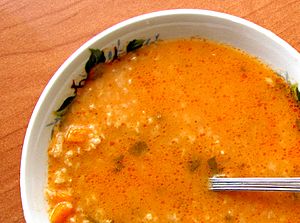
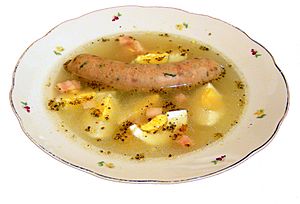
- Zupa pomidorowa - Thin tomato soup made with tomato purée, root vegetables and stock, usually served with pasta or rice, sour cream is often added.
- Kartoflanka - Potato soup with root vegetables.
- Czarnina also Czernina - Duck soup or duck blood soup made with duck broth and duck blood, the latter giving the soup a dark color, almost black colour. Recipes vary widely, but often sweet and sour ingredients are added, typically vinegar and often sugar, fruit juice or fruit (e.g., prunes, pears) and it is usually served with the duck meat and Kluski-style noodles. Nowadays, it's not commonly eaten.
- Chłodnik litewski - Cold beet leaves' soup made of soured milk or sour cream, young beet leaves, cucumbers and chopped fresh dill. Sometimes chives and radishes are added.
- Botwinka - Beet leaves soup with potatoes and root vegetables, served hot.
- Barszcz czerwony - Red borscht - Clear beetroot soup made out of stock, beetroots and beetroot sourdough. It's used to be served with uszka, krokiet made from naleśniki, pasztecik, pierogi and rarely with white beans, red kidney beans or mashed potatoes. It's a very important dish during Christmas Eve.
- Zupa buraczkowa - Beetroot soup with grated betroots, potato cubes and root vegetables. Sometimes it's called red borscht, like the one cooked during Christmas Eve even though it doesn't contain beetroot sourdough - it's slightly sweet but not sour.
- Barszcz ukraiński - Ukrainian borscht - Beetroot soup with addition of sliced white cabbage, white or red kidney beans beans and diced tomatoes or tomato purée. In Ukraine beans are not used in this dish.
- Zupa szczawiowa - Sorrel soup made of sorrel leaves and rice, served with hard boiled egg.
- Flaki or Flaczki - Beef or pork tripe stew with marjoram and spices. Vegetarians make this soup with oyster mushrooms.
- Rosół - Clear chicken soup served with noodles, usually short vermicelli. Stock is made of root vegetables and whole chicken, beef or both.
- Zupa grzybowa/pieczarkowa - Mushroom soup made of white or wild mushrooms with potatoes or pasta. During Christmas Eve it's rather served with łazanki pasta or uszka.
- Zupa ogórkowa - sour cucumber soup of sour, salted cucumbers.
- Żur - Żur is made of wholemeal rye sourdough, although in Lesser Poland and Podlachia oat sourdough is used and in Lublin Voivodeship buckwheat surdough is chosen. Like other two soups below it's served with mashed potatoes, hard-boiled eggs, cooked and smoked bacon and biała kiełbasa (white kielbasa).
- Żurek - It's more delicate than żur because it's made of wheat flour sourdough. Colloquially but improperly it's often called barszcz biały (white bortscht).
- Barszcz biały - Traditionally cabbage sourdough (sauerkraut's juice) or cucumber sourdough (sour pickled cucumbers' juice) is used. Still they can be replaced by using citric acid.
- Zalewajka - Rye soup - żur served with sliced smoked pork sausage, cooked and smoked bacon and separately cooked and diced potatoes.
- Grochówka - Pea soup with split peas, potato, carrot, parsley root, kielbasa or fried bacon and marjoram.
- Zupa fasolowa - Bean soup - white beans, root vegetables, smoked sausage (kielbasa), fried bacon and marjoram.
- Zupa kapuściana - White cabbage soup - stock, chopped white cabbage, root vegetables, tomato puree and potatoes.
- Kapuśniak - Sauerkraut soup, potatoes, root vegetables (parsley root, carrots, celery root), bacon and pork ribs.
- Kwaśnica - Sauerkraut soup with potatoes and ribs. Other vegetables like in a soup above are not used and this soup is also more sour.
- Zupa jarzynowa - Vegetable soup: potatoes, green beans, root vegetables, cauliflower, peas and sometimes brussels sprouts.
- Zupa ryżowa - Rice soup: rice, potatoes and root vegetables with chicken.
- Zupa koperkowa - Dill soup: chicken stock, root vegetables, a big amount of dill, spring onion, potatoes/baby potatoes and sometimes with sour or double cream.
- Zupa chrzanowa - Horseradish soup: white kielbasa, smoked bacon or pork ribs, sour cream, horseradish, garlic, potatoes and root vegetables for stock. Can be served with hard-boiled eggs.
- Forszmak lubelski - Pork or beef, smoked bacon, white mushrooms, sour pickled cucumbers, red bell pepper, tomato puree, spices, onion and garlic.
- Zupa gołąbkowa - Soup with minced meat, cabbage, tomato puree, tomatoes, rice and spices.
- Zupa meksykańska - Mexican soup: minced pork/beef, garlic, red kidney beans, corn kernels, canned tomatoes, tomato puree and onion. Potatoes and root vegetables may be added or not.
- Zupa kalafiorowa - Cauliflower soup: stock, potatoes, cauliflower florets and root vegetables.
- Zupa brokułowa - Broccoli soup: stock, potatoes, broccoli florets and root vegetables.
- Chłodnik - cold soup made of raw, partially blended or cooked and chilled vegetables with yoghurt or sour cream. Often served with cooked potatoes and/or hard-boiled eggs. There are: cucumber chłodnik, tomato chłodnik etc.
- Zupa gulaszowa - Goulash soup: pork, beef, potatoes, onion or leek, passata, tomato puree, paprika and red bell pepper. It's similar to Hungarian goulash, however Polish goulash is similar to pörkölt.
- Zupa soczewicowa/z soczewicy - Lentil soup: green or red lentils, garlic, tomatoes, tomato puree, onion and double or sour cream. May be served with pasta or potatoes.
- Zupa owocowa - Fruit soup, served cold with different fruits and pasta during hot summer.
Meat and fish
- Baranina - Roasted, stewed or grilled mutton.
- Bigos - Mainly smoked kielbasa and bacon stew. It's made with sauerkraut or cabbage only as well as in a combination of both, mushrooms, onions and sometimes with addition of tomato puree. It's known as a "hunter's stew" due to the addition of game and scraps of other meats.
- Bitki wołowe z pieczarkami/grzybami - Thin slices of beef braised with mushrooms.
- Bitki wieprzowe w sosie własnym - Thin slices of pork in gravy, braised with onions.
- Golonka - Stewed pork knuckle or hock.
- Gołąbki - Cabbage rolls with ground meat and rice or groats, served with mushroom, dill or tomato sauce. For Christmas Eve meat may be substituted with and mushrooms. Other verity include mushroom and potato filling mostly found in Eastern Poland due to influence from Ukraine. Cabbage leaves used are from savoy cabbage or white/common cabbage. Rarely can be made with red cabbage or sauekraut leaves. Modern versions include use of chinese cabbage or filling wrapped in zucchini slices. This dish is either cooked or baked.
- Gołąbki bez zawijania - Gołąbki without wrapping - Large meatballs filled with chopped cabbage, onion and rice.
- Gulasz - Meat stew originated from Hungary pörkölt with onions, tomatoes, red bell peppers and/or paprika.
- Karkówka - Pork neck, roasted, grilled or braised with onions.
- Kiełbasa - Sausage, smoked or boiled, is a staple of Polish cuisine and comes in dozens of varieties, made usually with pork.
- Kotlet mielony - Minced meat (pork, pork-beef or turkey) patty made with egg, breadcrumbs, chopped onions, wet bread and spices, often rolled in breadcrumbs. Sometimes filled with cheese and/or mushrooms.
- Kotlet schabowy - Pounded thinly pork loin cutlet coated in breadcrumbs. It's a variation of schnitzel.
- Kurczak Pieczony - Roasted chicken.
- Pieczeń cielęca - Roasted veal.
- Pieczeń wieprzowa z winem - Roasted pork in wine gravy.
- Polędwiczki wołowe - Braised beef sirloin slices.
- Pulpety or Klopsiki w sosie - Polish style meatballs in tomato, mushroom or dill sauce.
- Rolada z mięsa mielonego z pieczarkami - Minced meat roulade with mushrooms.
- Schab Faszerowany - Stuffed pork loin.
- Wołowina Pieczona - Roasted beef.
- Zrazy zawijane - Thin beef fillets rolled and filled with bacon, mushrooms, mustard, gherkins and onions.
- Roladki schabowe/z kurczaka - Thin pork/chicken fillets rolled with filling including version with cheese.
- Żeberka wędzone - Smoked Spare ribs.
- Filet z dorsza - Cod fillet with or without batter. Can be steam cooked or baked.
- Łosoś - Steamed or baked salmon fillet.
- Pstrąg - Poached or baked trout.
- Rolmopsy - Rolled pickled herring fillets stuffed with pickled onion and/or cucumbers.
- Ryba Smażona - Fried breaded fish fillet.
- Śledzie - Herring marinated in oil or vinegar with onions.
- Śledzie w śmietanie - Herring marinated in sour cream with onions. Sour pickled cucumbers, apples and mushrooms can also be added.
- Zimne nogi - Polish savoury jelly originating from Jewish cuisine based on bone broth made from pork legs and served with chopped meat and vegetables, like peas or carrots. Served with drizzle of vinegar or lemon juice. Dish using other meat than pork leg is called galareta.
Flour or potato-based
- Pierogi - Half moon shaped dumplings with various fillings. Savoury pierogi may be filled with sauerkraut and mushrooms, with potato, quark and fried onion (pierogi ruskie - Ruthenian pierogi), with minced meat or with buckwheat groats and quark or mushrooms. Sweet pierogi can be made with sweet quark or with fruits such as blueberries, strawberries, cherries, plums, raspberries, apples or chocolate even.
- Uszka - tiny dumplings traditionally filled with mushrooms and onions only. Other fillings used are mushrooms with sauerkraut or rarely cooked and minced meat with onions. They are served with clear Borscht, clear mushroom soup or broth when with meat filling.
- Kołduny - stuffed dumplings with raw minced beef and mutton, beef dripping, fried onions and spices. Potato kalduny is a different dish from Subcarpathia made from potato dough filled with twaróg (quark), potatoes and onions.
- Placki ziemniaczane/kartoflane - Potato pancakes with grated potatoes, onions, eggs, wheat flour and marjoram.
- Pyzy - Potato dumplings made with raw, grated potatoes, egg and flour filled with minced meat or not filled at all. Then cooked.
- Knedle - Potato dumplings made with cooked potatoes and starch filled usually with fruits, most popular fillings are plums and strawberries.
- Kopytka - Hoof-shaped potato dumplings made of cooked potatoes, egg and flour. Often served with breadcrumbs, sugar and melted butter or fried bacon.
- Pierogi / Kluski leniwe - Hoof-shaped dumplings made of flour or potatoes, eggs and quark.
- Kluski śląskie - Dumplings in small donut-like shape made with boiled potatoes and potato starch. Often served with gravy or meat stew.
- Czarne/Szare kluski - Dumplings black/gray in colour made of raw grated potatoes and potato starch.
- Pampuchy/Kluski na parze/ Pyzy drozdżowe - Steamed yeast wheat flour dumplings served with fruit yoghurt or jam. They can be also served savoury with gravy or filled with chocolate.
- Kluski kładzione (Laid dumplings) - Dumplings made of thick batter with flour and eggs laid to boiling water.
- Lane Kluski (Poured dumplings) - Dumplings made of thin batter with flour, milk end eggs poured straight to soup usually.
- Zacierki (Grated dumplings) - Grated or chopped dough into tiny balls and cooked.
- Naleśniki - Thicker and more plump version of crepes, served with sweet or savoury filling.
- Krokiety - In Poland they are made of naleśniki, filled often with sauerkraut and mushrooms or ham and cheese, then folded like burrito, breaded and fried. It's common to serve them with clear Borscht.
- Racuchy - Yeast pancakes often stuffed with apples and served with powdered sugar or jam.
- Łazanki - Pasta in a shape of small squares, in Polish version served with sauerkraut, onion and fried kielbasa or fried bacon.
- Zapiekanka - baked Polish fast food, main ingredient is veka roll sliced in half with tomato sauce, mushrooms and cheese on top. Zapiekanka can also be anything baked in casserole dish with added egg and cream mixture, so it holds together when removed. It usually involves meats, vegetables with potatoes or pasta and melted cheese on top.
- Knysza - Polish fast food with yeast bread roll filled with red and white cabbage, tomato, cucumber, pickled cucumber, onion, fried onion, corn and sometimes fried chicken meat with garlic mayonnaise sauce. It originated in Wroclaw.
- Smażone ziemniaki/bratkartofle - Fried, often previously cooked slices of potatoes, usually eaten with fried egg/mixed in scrambled eggs, onions and grilled/fried sausage which can be also sliced beforehand. Whole dish and serving with eggs (bratkartoffeln mit ei) or sausage (bratkartoffeln mit wurst) comes from Germany. In Poland often eaten with a glass of sour Buttermilk or kefir.
- Makaron z jajkiem - Fried and previously cooked pasta with fried onions, scrambled eggs and butter. Sometimes cheese, bacon or ham can be added. It's a version of Italian spaghetti con uova e cipolla or spaghetti carbonara.
Side dishes and salads
- Kasha - Cooked groats, most popular are groats of buckwheat, barley, millet and wheat.
- Mizeria - Traditional Polish salad which came from France, made with sliced cucumbers, sour cream and spices, served as a side.
- Surówka z jabłka i marchewki - Carrot salad made with peeled and grated carrots, apples, oil and lemon juice.
- Surówka z ogórków i pomidorów - Salad made with cucumbers, tomatoes, onions and oil or sour cream.
- Ziemniaki gotowane - Simple boiled potatoes sprinkled with dill.
- Tłuczone ziemniaki - Mashed potatoes.
- Surówka z białej kapusty - Salad with shredded cabbage, carrots and spices, often with grated apples.
- Surówka z kiszonej kapusty - Salad with sauerkraut, carrots, parsley, apples and lemon juice.
- Sałatka warzywna or Jarzynowa - Vegetable salad which is a traditional Polish side dish with cooked vegetables such as parsley root, carrot, potatoes, celery root, pickled cucumbers in brine and hard-cooked eggs in mayonnaise and mustard. In salad can also often be corn, peas, apple, onion or leek and red kidney beans even.
- Kapusta zasmażana - Sauerkraut or white cabbage pan-fried with onions and spices, often with fried bacon.
- Kapusta na gęsto - Braised white cabbage with onions, dill and double cream.
- Surówka - This term is used for any type of salad made of raw vegetables with drizzle of vinegar, oil, sour cream or yoghurt.
- Sałatka - Term used for any salad made of cooked vegetables, usually with mayonnaise.
- Sałatka burakowa/buraczki tarte - Cooked and grated beetroot salad, can be made warm or cold.
- Ćwikła - Cooked and grated beetroots with horseradish paste and lemon juice.
- Fasolka szparagowa z czosnkiem - Green beans with garlic and butter/oil, originated in Italy.
- Kalafior/fasolka szparagowa/brukselka z bułką tartą - Cooked cauliflower/green beans or Brussels sprouts with polonaise sauce. The sauce is made of fried breadcrumbs in butter.
- Brokuł/kalafior z sosem czosnkowym - Cooked broccoli/cauliflower with garlic sauce.
- Ogórek kiszony - Polish pickled cucumber, it's fermented in brine consisting of dill and dill flower, garlic, salt and spices.
- Ogórek konserwowy - Pickled cucumber in vinegar, which is rather sweet and vinegary in taste.
- Grzyby marynowane - Marinated mushrooms.
- Sałatka szwedzka - Preserved salad made with cucumbers, onions, carrots, vinegar and spices.
- Sałatka ziemniaczana - Potato salad originating from Germany, made with cooked potatoes, onions, pickled cucumbers, dill and mayonnaise, sometimes with added smoked bacon or herring fillets marinated in oil or vinegar.
- Sałatka śledziowa - Marinated herring salad with pickled cucumbers, onions and sour cream. Sometimes eggs and apples are added.
Bread
Bread (chleb) and bread rolls (bułka (bread roll), Bajgiel, Rogal, Bułka paryska) makes the Polish cuisine and tradition complete. It has been an essential part of them both for centuries. Today bread remains one of the most important foods in the Polish cuisine. The main ingredient for Polish bread is rye or wheat. Traditional bread has a crunchy crust, is soft but not too soft inside, and has unforgettable aroma. Such bread is made with sourdough, which lends it a distinctive taste. It can be stored for a week or so without getting too hard and is not crumbly when cut.
In Poland, welcoming with bread and salt ("chlebem i solą") is often associated with the traditional hospitality ("staropolska gościnność") of the Polish nobility (szlachta), who prided themselves on their hospitality. A 17th-century Polish poet, Wespazjan Kochowski, wrote in 1674: "O good bread, when it is given to guests with salt and good will!" Another poet who mentioned the custom was Wacław Potocki. The custom was, however, not limited to the nobility, as Polish people of all classes observed this tradition, reflected in old Polish proverbs. Nowadays, the tradition is mainly observed on wedding days, when newlyweds are greeted with bread and salt by their parents on returning from the church wedding.
Desserts and sweets
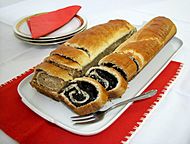
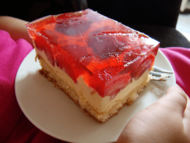
- Beza - Type of sweet meringue in biscuit form, occasionally with topping.
- Makowiec - Sweet poppy-seed swiss roll, with raisins, dried fruits and walnuts.
- Pączek - Closed donuts filled with rose petal jam, other fruit conserves, custard, chocolate or quark with sugar.
- Pierniki - Soft gingerbread biscuit forms of pryanik unfilled or filled with marmalade of different fruit flavours and sometimes covered with chocolate.
- Sernik - Sernik (cheesecake) is one of the most popular desserts in Poland. It is a cake made primarily of twaróg, a type of fresh cheese similar to quark. It can be baked or refrigerated. It might be flavoured with vanilla, lemon peel or orange peel. Sometimes raisins or various fresh fruits are added. It is also common to top it with a chocolate topping or sprinkled with coconut-flakes, nuts. It is very popular to garnish it with a sweet jelly topping with a variety of fresh fruits when it's unbaked.
- Mazurek - Pie baked particularly at Christmas Eve and Easter, made with Schortcrust pastry. There are variations with different fillings, such as walnut paste, dulce de leche or ganache with dried fruits, candied fruit and nuts.
- Chałka - Sweet white wheat bread of Jewish origin (Challah).
- Kogel mogel - eggnog, made from egg yolks, sugar, and flavourings such as honey, vanilla or cocoa. Traditional for Polish Jews.
- Krówki - Polish fudge, soft milk toffee candies.
- Napoleonka - Polish type of cream pie made of two layers of puff pastry, filled with vanilla pastry cream, usually sprinkled with powdered sugar, close relative of the French millefeuille. Alternative but less popular name is kremówka often with filling of whipped cream instead of custard cream.
- Keks - Cake with candied and dried fruit.
- Babka - It's Polish version of a pound cake, made with or without yeast. It is served with powdered sugar or icing. Can be made as a marble cake also.
- Miodownik - Layered honey cake filled with vanilla pastry cream and ganache on top.
- Orzechowiec - Layered nut cake filled with vanilla pastry cream and kajmak with chopped nuts on top.
- Ciasto marchewkowe - Carrot cake with added nuts and honey, sometimes layered with whipped cream.
- Ciasto bez pieczenia/na zimno - Various types of unbaked and refrigerated cakes made of biscuits, ladyfingers, crackers or sponge cake with vanilla, whipped cream, coconut, jelly, mascarpone, semolina, or poppy seed filling often with ganache on top.
- Karpatka - Cream pie made of two layers of choux pastry filled with vanilla pastry cream.
- Wuzetka - Layered chocolate sponge cake filled with jam and whipped cream, associated with Warsaw.
- Ptasie mleczko - Chocolate-covered candy filled with soft meringue (or milk soufflé).
- Kisiel - Clear, jelly-like sweet fruit liquid, made with starch, sugar and fruits or fruit juice.
- Budyń - Pudding, usually comes in many different flavors, such as sweet cream, vanilla, chocolate, cherry etc.
- Faworki - Light fried pastry covered with powdered sugar.
- Pańska Skórka, Miodek - Kind of hard Taffy sold at cemeteries during Zaduszki and at Stare Miasto (Old city) in Warsaw.
- Kutia - Grain dish made with wheat, poppy seeds, nuts, raisins and honey. Not traditionally Polish, but served during Christmas in the eastern regions (Białystok, Podlachia).
- Prince Polo - Polish chocolate bar.
- Mieszanka Wedlowska - Assorted chocolate covered candy.
- Torcik Wedlowski - Large, circular, chocolate covered wafer with hand-made decorations.
- Pawełek - Chocolate bar with a flavored filling, most popular contains advocaat.
- Śliwka w czekoladzie - Chocolate-covered prune
- Ryż z jabłkami - Type of a rice pudding baked or cooked with apples and cinnamon.
Beverages
Alcoholic
Traditional Polish alcoholic beverages include mead, beer, vodka (old Polish names: okowita, gorzała) and to a lesser extent wine. In recent decades beer has become very common, while wine is less frequently drunk, though in recent years the trend for its consumption is rising along with increasing production of local grape wines in small vineyards in Lesser Poland, Subcarpathia, Silesia and West Pomerania regions. Among the alcoholic beverages, Polish vodka is traditionally prepared from grain or potatoes – it essentially displaced the formerly widespread mead.
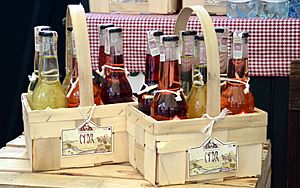
Some sources suggest that the first production of vodka took place in Poland as early as the 8th century, becoming more widespread in the 11th century. The world's first written mention of the drink and of the word "vodka" was in 1405 from Akta Grodzkie recorder of deeds, the court documents from the Palatinate of Sandomierz in Poland.
Vodka production on a much larger scale began in Poland at the end of the 16th century. By the 17th and 18th centuries, Polish vodka was known in the Netherlands, Denmark, England, Russia, Germany, Austria, Hungary, Romania, Ukraine, Bulgaria and the Black Sea basin. Vodka was the most popular alcoholic drink in Poland until 1998, when it was surpassed by beer.
Besides clear vodkas, flavoured vodka (known as nalewka) and liqueurs are also popular. The most important are Żubrówka (vodka with bison grass from Podlasie), herbal Żołądkowa Gorzka, aged Starka, plum brandy śliwowica (especially from Łącko), honey liqueur Krupnik as well as Goldwasser (herbal liqueur with flakes of gold leaf) and juniper vodka machandel, both originating from Gdańsk.
Non-alcoholic
Traditionally, kwas chlebowy was a fermented beverage that was at first popular among the peasantry, but later spread to the szlachta also and had become a universal Polish drink by the 14th-15th centuries. It is typically made from rye bread, usually known as black bread, and is not classified as an alcoholic beverage in Poland, as its alcohol content usually ranges from 0% to 2%. There are many commercial and family variations of the beverage; however, traditional Polish recipes still exist. Despite its production on an industrial scale in Poland during the interbellum, it began to lose out in popularity to mass-produced soft drinks and carbonated water in the 20th century. It remained known primarily in rural areas of eastern Poland. However, kvass started making a comeback in the 21st century with many new Polish brands being started.
In contemporary times, tea is perhaps the most popular, drunk sometimes with a slice of lemon and sweetened with sugar. Tea came into Poland from England shortly after its appearance in Western Europe, mainly due to the Dutch merchants. However, its prevalence is attributed to the Russians in the 19th century – at this time samovars imported from Russia become commonplace in Polish homes. Tea is usually served with a slice of lemon and sweetened with either sugar or honey. Tea with milk is called a bawarka ("Bavarian style").
Coffee is also widely drunk since the 18th century, as Poland bordered the Ottoman Empire at the time. Frequently consumed beverages also include: buttermilk, kefir, soured milk, instant coffee, various mineral waters, juices and numerous brands of soft drink. A considerable number of Poles enjoy carbonated water and customers in restaurants are always offered both still and sparkling (carbonated) water to drink.
See also
 In Spanish: Gastronomía de Polonia para niños
In Spanish: Gastronomía de Polonia para niños






